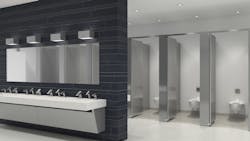Airport restroom technology is increasing in demand as airports look to enhance the passenger experience and improve operations. While new innovations are coming onto the market every month, it’s difficult for airports to know what will fit their needs.
But if you consider trends in the marketplace, customer demands and anticipate the new permanent changes coming to public sanitation due to the COVID-19 pandemic, it can focus the products to best fit your airport.
Kevin Smith vice president of technology for Corvado, a cloud-based facility maintenance software provider, said smart restrooms doesn’t just mean implementing new technology. It also means being very conscious of the manual activity that goes into keeping restrooms clean.
“You want to take advantage of all the technology like available datapoints like the expected volume of people on a given day and how do you align that anticipated volume of traffic with the right amount or resources required to clean and sanitize your facilities,” he said.
Studies by JD Powers and Airports Council International (ACI) show passengers are willing to spend more when restrooms are cleaner. Smith said Corvado found concessionaires near restrooms with higher cleanliness scores have higher sales receipts than by those with lower ratings.
Paper indicators for hand towels and toilet paper can be tracked to determine when staff can refill them without leaving customers in the lurch.
Anna Königson Koopmans, marketing director at Essity, said digital technology is a key tool in meeting customer satisfaction in airports. Bringing this technology into the restroom is a continuation of optimization of operations.
“It’s about getting higher satisfaction with less effort,” she said. “You’re redeploying your resources in a different way to get use where they’re needed the most.”
There’s a strong demand for data, so airport management can understand operations better and optimize them. Königson Koopmans said airports need to understand what datapoints they want to track to get the results they’re seeking.
For example, she said data shows 89 percent of all dispenser checks are unnecessary. Tracking dispenser levels will eliminate those unnecessary actions. You can also track footfall to understand traffic patterns within the terminal to see which bathrooms may be under cleaned or over cleaned.
The value of having data is even bigger than we thought in the beginning,” Königson Koopmans said. “Sometimes we get data that was unexpected.
Giving maintenance staff access to the information empowers them to address issues when they occur. Königson Koopmans said airport cleaners have less stress on their tasks knowing where and when they need to address an issue before it became a complaint. It also provides more meaning to their job.
Nancy Ferrell, marketing manager for Essity, said empowered cleaning staff have higher job satisfaction, which reduces turnover.
“By empowering both the manager and also staff, you’ll get bigger results,” Königson Koopmans said.
The post COVID-19 World
Touchless technology will be a must in the post-COVID-19 world.
Morgan Butts, Sloan product line managers for sinks, soap dispensers and hand dryers, said airports are focusing on touch-free products now more than ever before and want to enhance the look of their restrooms to provide a high-end aesthetic. This goal of having both high functionality and beauty makes it critical for airports to be selective about the products they choose for the entire facility, especially in public restrooms.
“The public has also been demanding more touch-free, hygienic products,” Butts said. “To save time and money, customers are asking to purchase a set of restroom touch-free fixtures and fittings from one manufacturer.”
In recent years, some of the changes have been driven by new technology such as Bluetooth-enabled faucets that help facility managers troubleshoot without the need to close down the restrooms. They can also use this technology to program in-line flushes, which help reduce standing water in systems with infrequently used faucets and restrooms.
“This technology is also used by smaller airports to implement a morning line flush to clean out any cold water that was in the lines overnight,” Butts said. “This can reduce first use, ice cold water and provide a big improvement to the customer experience.”
With touchless fixture operations, especially the products with Bluetooth capabilities, the operation teams should be able to resolve product issues faster, and the first time around. With just a quick scan of the faucet, an app can tell them the battery level, the sensor strength, and whether the solenoid needs replacement, among other maintenance needs. More uptime leads to higher customer satisfaction.
With sensor products, operation teams should see less misuse, with no user feeling the need to kick the flush valve in order to complete the flush because they don’t want to touch the handle. With Sloan’s AER-DEC sink, paper towel usage is reduced, and this decreases the likelihood of paper towels being flushed down the toilet and causing clogging issues. A cleaner, easier to use restroom makes users happier and ultimately gets them back out to the terminals faster.
Smith said customers want to reduce anxiety and feel a sense of cleanliness in an airport bathroom.
“After this existing global pandemic, we’re going to want to activate our economy by getting people to in a state of consistent travel again,” Smith said. “People are going to want a confidence indicator just like you would if you go to a restaurant that reflects cleanliness.”
The pandemic stresses the need to track items like soap, which Smith said now can be a life or death situation for a traveler.
“The datapoints don’t need to be overly complex to know what we have,” he said.
Smith said some airports are testing biometrics at the entrance of a bathroom. The facial expressions of travelers coming out can indicate if they had a bad experience with cleanliness, which gives real time information to staff about an issue.
“We’ve all seen those happy faces when we’re coming out of the bathrooms, but nowadays with this global pandemic, no one wants to touch anything,” he said. “As great as that technology is and was, it just became obsolete because nobody wants to touch anything near a restroom or another kind of surface.”
Butts said each passing day brings a greater need for hygienic, touch-free experiences. This is especially important in high-traffic public restrooms. Travelers will become much more aware of how many surfaces they touch and what germs they could encounter in crowded public spaces.
“We’re seeing locations that have manual flushometers now utilizing Sloan’s retrofit flushometer kits to transform their restrooms into touchless spaces because users are not willing to touch the handle,” she said. “I think this crisis will dramatically change how everyone looks at public spaces in the future, and there will be an even stronger call for clean and hygienic restrooms.”
Butts said if an airport hasn’t switched from manual products to sensor-operated products, this should be their wake-up call. Our world is now more connected than ever before. As people are traveling more they are also becoming more educated about how to keep themselves healthy. Airports especially need to stay up-to-date with their users’ needs and make sure they are supplying environments that make guests feel welcome, comfortable, and safe.
The power of scent
Chris Whiting, executive vice president of sales, North, Central, & South America, for Oxy-Gen Powered, said odor elimination is very important in transportation hub because it’s the first impression left on travelers.
“If it smells fresh and clean, they have a really good feeling that everything is run properly, it’s well maintained and things are indeed, fresh, clean and sanitary,” he said. “In times like these, that’s never been more important when building the confidence of your customers.”
There are two ways to tackle odor—control and mitigation. Control tries to mask odors via aerosol sprays. Mitigation products eliminate the actual odors at a molecular level. Whiting said airports need to focus on odor elimination.
“That perception of clean is a really big part of the brand,” he said. “When you think of certain transportation hubs, as soon as you hear the name, there’s things about the brand that stand out. That freshness and cleanliness permeates the brand and makes it very strong and fantastic or it diminishes it.”
A Harris Poll conducted by Oxy-Gen found 56 percent of all Americans said they assume a facility isn’t run well or clean when they detect a foul odor. They have a negative perception of the business and will avoid it. They’re less willing to shop, which can diminish concessions and retail sales in the terminal.
The traditional air freshening systems utilize aerosol cans on a metered release. It’s programmable by time, but the spray drifts to the floor and emits different emissions into the environment. Whiting said Oxy-Gen uses a fuel cell to provide consistent fragrance for up to 90 days.
“Facility managers are looking for one thing—consistency,” he said. “They want their clients’ experience to be the exact same every day and to be positive every day.”
The company is releasing Oxy-Gen Smart, which tells staff when to replace cartridges and report performance issues. It connects to a smartphone device utilizing Bluetooth.
Do your homework
Smith said airports should check with peers when choosing a program to track restrooms. A solution in a Tier 1 airport may not be the best fit for a Tier 5 facility. Find out what they’re using and find out what works.
“They should define a set of requirements, evaluate options that work at similar facilities and make sure that data can be captured and shared,” he said. “They should put it in a format so they can share it with their public and employees. It’s a great concern when global pandemics like this hit.”
Getting the right system comes down to math, Whiting said. Look at space and usage and how air will move around a facility. He said it’s also a good idea to make sure scents match with other devices.
“Like a matching urinal screen, should match,” he said. “It may be little, but it’s one of those things where people will feel ‘wow, management really has their act together.’”
Transportation hubs have large amounts of people coming in at certain times. Using aerosol sprays along won’t work unless they’re timed perfect to meet the demand of traffic.
“If you have something clean and fresh, it doesn’t bowl you over with a lot of sweetness, if it’s subtle, and fresh it’s really important,” Whiting said. “But you have to have odor elimination.”
Butts said airport should also consider product repairability. Maintenance and repair happen frequently in commercial spaces, and as sites choose more beautiful designs, they want to make sure that they can easily maintain that product over its lifetime. This is why specifiers should make sure the products they are selecting are designed for commercial environments.
“There are some great products designed for residential applications, but they don’t stand up to the needs of high use facilities such as airports,” she said. “For example, specifiers can choose materials such as solid surface sink materials that are repairable if they get scratched or chipped.”
About the Author
Joe Petrie
Editor & Chief
Joe Petrie is the Editorial Director for the Endeavor Aviation Group.
Joe has spent the past 20 years writing about the most cutting-edge topics related to transportation and policy in a variety of sectors with an emphasis on transportation issues for the past 15 years.
Contact: Joe Petrie
Editor & Chief | Airport Business
+1-920-568-8399
>> To download the AviationPros media kits, visit: Marketing Resource Center
>>Check out our aviation magazines: Ground Support Worldwide | Airport Business | Aircraft Maintenance Technology

